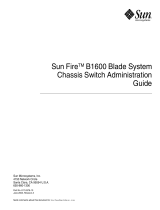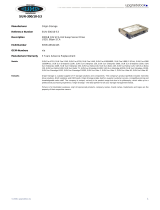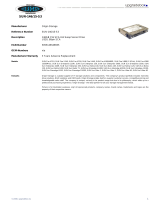Page is loading ...

iii
Contents
Preface xi
1. Watchdog Timer 1
Overview 1
PICL Plug-In Module 2
Watchdog Node Management Code 5
OpenBoot PROM Interface 21
2. Environmental Monitoring 23
Environmental Monitoring Component Compatibility 24
Typical Environmental Monitoring System Application 24
Typical Cycle From Power Up to Shutdown 26
Environmental Monitoring Protection at the OpenBoot PROM 26
Environmental Monitoring Protection at the Operating System Level 26
Post Shutdown Recovery 27
Hardware Environmental Monitoring Functions 28
Switching Power On and Off 31
Inlet, Exhaust, and CPU Temperature Monitoring 31
Adjusting the Environmental Monitoring Warning, Critical, and Shutdown
Parameter Settings on the Board 32
OpenBoot PROM Environmental Monitoring 33

iv Netra CP2500 Board Programming Guide • March 2007
Warning Temperature Response at OpenBoot PROM 33
Critical Temperature Response at OpenBoot PROM 33
Using the show-sensors Command at the OpenBoot PROM 34
Environmental Monitoring Application Programming 34
Reading Temperature Sensor States Using the PICL API 35
Using a Configuration File for Sensor Information 36
Solaris Driver Interface 36
Sample Application Program 37
Reading the CPU Temperature and Environmental Limits 41
3. User Flash 43
User Flash Usage and Implementation 43
User Flash Driver 44
OpenBoot PROM Device Tree and Properties 44
User Flash Device Files 45
Interface (Header) File 45
Application Programming Interface 45
Structures to Use in IOCTL Arguments 46
PROM Information Structure 46
User Flash User Interface Structure 47
Errors 47
Example Programs 47
Read Example Program 48
Write Example Program 49
Block Erase Example Program 51
Sample User Flash Application Program 53
Index 59

vi Netra CP2500 Board Programming Guide • March 2007

vii
Tables
TABLE 1-1 Watchdog Plug-In Interfaces for Netra CP2500 Board Software 3
TABLE 1-2 Properties Under watchdog-controller Node 3
TABLE 1-3 Properties Under watchdog-timer Node 4
TABLE 2-1 Compatible Environmental Monitoring Components 24
TABLE 2-2 Typical Netra CP2500 Board Hardware Environmental Monitoring Functions 28
TABLE 2-3 I2C Components 28
TABLE 2-4 PICL Temperature Sensor Class Node Properties 35
TABLE 2-5 Description of Values Displayed by Solaris Commands 42
TABLE 3-1 User Flash Node Properties 44
TABLE 3-2 System Calls 45

viii Netra CP2500 Board Programming Guide • March 2007

ix
Code Samples
CODE EXAMPLE 1-1 System Watchdog Node Management Code Example 5
CODE EXAMPLE 2-1 Sample envmond Application Program 37
CODE EXAMPLE 3-1 PROM Information Structure 46
CODE EXAMPLE 3-2 User Flash Interface Structure 47
CODE EXAMPLE 3-3 Read Action on User Flash Device 48
CODE EXAMPLE 3-4 Write Action on User Flash Device 49
CODE EXAMPLE 3-5 Block Erase Action on User Flash Device 51
CODE EXAMPLE 3-6 Sample User Flash Application Program 53

x Netra CP2500 Board Programming Guide • March 2007

xi
Preface
The Netra CP2500 Board Programming Guide is written for program developers and
users who want to program the Netra
™
CP2500 board in order to design original
equipment manufacturer (OEM) systems, supply additional capability to an existing
compatible system, or work in a laboratory environment for experimental purposes.
You are required to have a basic knowledge of computers and digital logic
programming to fully use the information in this document.
The Netra CP2500 can be used by network equipment providers (NEPs) and carriers
to scale and improve the availability of next-generation, carrier-grade systems. The
Netra CP2500 functions as a node board in a cPSB system rack or as a CPU board in
the Netra CT 810 or 410 cPCI server.
How This Book Is Organized
Chapter 1 provides details on the Netra CP2500 watchdog timer driver and its
operation.
Chapter 2 describes the specific environmental monitoring functions of the Netra
CP2500.
Chapter 3 describes the user flash driver for the Netra CP2500 on-board flash
PROMs and how to use it.

xii Netra CP2500 Board Programming Guide • March 2007
Using UNIX Commands
This document may not contain information on basic UNIX
®
commands and
procedures such as shutting down the system, booting the system, and configuring
devices.
See one or more of the following for this information:
■ Solaris Handbook for Sun Peripherals
■ Solaris
™
Operating System (Solaris OS) documentation, which is at:
http://docs.sun.com
■ Other software documentation that you received with your system
Typographic Conventions
Typeface
*
* The settings on your browser might differ from these settings.
Meaning Examples
AaBbCc123 The names of commands, files,
and directories; on-screen
computer output
Edit your.login file.
Use ls -a to list all files.
% You have mail.
AaBbCc123 What you type, when contrasted
with on-screen computer output
%
su
Password:
AaBbCc123 Book titles, new words or terms,
words to be emphasized.
Replace command-line variables
with real names or values.
Read Chapter 6 in the User ’s Guide.
These are called class options.
You must be superuser to do this.
To delete a file, type rm filename.

Preface xiii
Shell Prompts
Related Documentation
Online documents are available at:
http://www.sun.com/documentation
Shell Prompt
C shell machine-name%
C shell superuser machine-name#
Bourne shell and Korn shell $
Bourne shell and Korn shell superuser #
Title Part Number
Netra CP2500 Board Release Notes 819-1748
Netra CP2500 Board Installation and Technical Reference
Manual
819-1747
Netra CP2500 Board Programming Guide 819-1749
Netra CP2500 Board Safety and Compliance Manual 819-1750
Netra CP2500 Rear Transition Module Installation and
Technical Reference Manual
819-1753
Important Safety Information for Sun Hardware Systems 816-7190

xiv Netra CP2500 Board Programming Guide • March 2007
Documentation, Support, and Training
Third-Party Web Sites
Sun is not responsible for the availability of third-party web sites mentioned in this
document. Sun does not endorse and is not responsible or liable for any content,
advertising, products, or other materials that are available on or through such sites
or resources. Sun will not be responsible or liable for any actual or alleged damage
or loss caused by or in connection with the use of or reliance on any such content,
goods, or services that are available on or through such sites or resources.
Sun Welcomes Your Comments
Sun is interested in improving its documentation and welcomes your comments and
suggestions. You can submit your comments by going to:
http://www.sun.com/hwdocs/feedback
Please include the title and part number of your document with your feedback:
Netra CP2500 Board Programming Guide, part number 819-1749-11
Sun Function URL
Documentation
http://www.sun.com/documentation/
Support
http://www.sun.com/support/
Training
http://www.sun.com/training/

1
CHAPTER
1
Watchdog Timer
The system management controller (SMC) on the Netra CP2500 implements a
watchdog service that captures catastrophic faults in the Solaris OS running on the
CPU board. The watchdog service reports such faults to the baseboard management
controller (BMC) by means of either an IPMI message or by a de-assertion of the
CPU’s HEALTHY# signal.
This chapter contains the following sections:
■ “Overview” on page 1
■ “PICL Plug-In Module” on page 2
■ “Watchdog Node Management Code” on page 5
■ “OpenBoot PROM Interface” on page 21
Overview
The Netra CP2500 SMC provides two watchdog timers: the watchdog level 2 (WD2)
timer and the watchdog level 1 (WD1) timer. Management applications (for example,
the Managed Object Hierarchy on the Netra CT 810/410 server or a third-party
application on a cPSB server) start the timers, and the Solaris OS periodically pats
the timers before they expire. If the WD2 timer expires, the watchdog function of the
WD2 timer forces the SPARC
®
processor to optionally reset. The maximum range for
WD2 is 255 seconds.
The WD1 timer is typically set to a shorter interval than the WD2 timer.
Management applications can examine the expiration status of the WD1 timer to get
advance warning if the main timer, WD2, is about to expire. The management
application has to start WD1 before it can start WD2. If WD1 expires, then WD2
starts only if enabled. The maximum range for WD1 is 6553.5 seconds.
The Solaris PICL module provides interfaces to the watchdog timer in SMC.

2 Netra CP2500 Board Programming Guide • March 2007
PICL Plug-In Module
The watchdog subsystem is managed by a platform information and control library
(PICL) plug-in module. This PICL plug-in module provides a set of PICL properties
to the system, which enables a Solaris PICL client to specify the attributes of the
watchdog system.
To use the PICL API to set the watchdog properties, your application must follow
the following sequence:
Note – The following instructions are not server-specific. Check your server
documentation for additional software configuration that might be needed with the
watchdog timer.
1. If the watchdog timer is running, stop it by disabling the primary HEALTHY#
signal monitoring for the CPU card on which the watchdog timer is to be
changed.
2. In your application, use the PICL API to disarm, set, and arm the active watchdog
timer.
Refer to the picld(1M), libpicl(3LIB), and libpicltree(3LIB) man pages for
a complete description of the PICL architecture and programming interface.
Develop your application to use the PICL programming interface to do the
following:
■ Disarm the active watchdog timer.
■ Change the watchdog timer PICL properties to the required values.
■ Re-arm the watchdog timer. The properties of watchdog-controller and
watchdog-timer are defined in
TABLE 1-1, TABLE 1-2, and TABLE 1-3.
3. Re-enable the primary HEALTHY# signal monitoring on the CPU card in the
specified slot.

Chapter 1 Watchdog Timer 3
PICL interfaces for the watchdog plug-in module include the nodes watchdog-
controller and watchdog-timer. See
TABLE 1-1, TABLE 1-2, and TABLE 1-3 for
descriptions of the properties of these nodes.
TABLE 1-1 Watchdog Plug-In Interfaces for Netra CP2500 Board Software
PICL Class Property Meaning
watchdog-
controller
WdOp Represents a watchdog subsystem.
watchdog-timer State Represents a watchdog timer hardware that belongs to its
controller. Each timer depends on the status of its peers to
be activated or deactivated.
WdTimeout Timeout for the watchdog timer.
WdAction Action to be taken after the watchdog expires.
TABLE 1-2 Properties Under watchdog-controller Node
Property Operations Description
WdOp arm Activates all timers under the controller with values already set for
WdTimeout and WdAction.
disarm All active timers under the controller will be stopped.

4 Netra CP2500 Board Programming Guide • March 2007
To identify current settings of watchdog-controller, issue the command
prtpicl -v as shown in the sample output below.
TABLE 1-3 Properties Under watchdog-timer Node
Property Values Description
State armed Indicates timer is armed or running. Cleared by disarm.
expired Indicates timer has expired. Cleared by
disarm.
disarmed Default value set at startup time. Indicates timer is disarmed or
stopped.
WdTimeout
*
* A platform might not support a specified timeout resolution. For example, Netra CT 810/410 systems only take -1, 0, and 100 to 6553500
msec in increments of 100 msec for level 1; and -1, 0, and 1000 to 255000 in increments of 1000 msec for level 2.
Varies by system
and timer level
Indicates the timer initial countdown value. Should be set prior
to arming the timer.
WdAction
\
\ A specific timer node might not support all action types. For example, Netra CT watchdog level 1 timer supports only none, alarm,
and reboot actions. Watchdog level 2 timer supports only none and reset.
none Default value. No action is taken.
alarm Sends notifications to system alarm hardware by means of
HEALTHY#.
reset Performs a soft or hard reset of the system (implementation
specific).
reboot Reboots the system.
# prtpicl -v
...
watchdog (watchdog-controller,26000000532)
:WdOp <WRITE-ONLY>
:_class watchdog-controller
:name watchdog
watchdog-level1 (watchdog-timer, 26000000536)
:WdAction alarm
:WdTimeout 0x2710
:State disarmed
:_class watchdog-timer
:name watchdog-level1
watchdog-level2 (watchdog-timer, 26000000539)
:WdAction none
:WdTimeout 0xffffffff
:State disarmed

Chapter 1 Watchdog Timer 5
Watchdog Node Management Code
CODE EXAMPLE 1-1 contains an example of the code used for managing the watchdog
timer nodes. This code can be used to change watchdog timer action and timeout
values and also to arm and disarm the watchdog controller.
:_class watchdog-timer
:name watchdog-level2
CODE EXAMPLE 1-1 System Watchdog Node Management Code Example
/*
* Copyright 2003 Sun Microsystems, Inc. All rights reserved.
* Use is subject to license terms.
*/
#pragma ident "@(#)wdadm.c 1.6 03/10/16 SMI"
/*
* This program is used to manage the system watchdog nodes.
* Please refer to libpicl(3LIB) for information on picl APIs
* To compile:
* cc -o wdadm -lpicl wdadm.c
*/
#include <stdio.h>
#include <stdlib.h>
#include <stdarg.h>
#include <string.h>
#include <strings.h>
#include <errno.h>
#include <alloca.h>
#include <libintl.h>
#include <locale.h>
#include <unistd.h>
#include <assert.h>
#include <inttypes.h>
#include <sys/termios.h>
#include <picl.h>
/*
* Error codes
*/
#define EM_USAGE 0

6 Netra CP2500 Board Programming Guide • March 2007
#define EM_INIT 1
#define EM_GETROOT 2
#define EM_GETPVALBYNAME 3
#define USAGE_STR "Usage:\n"\
"wdadm -l [<controller_name:timer_name>...]\n"\
"wdadm -m <controller_name:timer_name> [-t <timeout>]"\
" [-a action]]\n"\
"wdadm -c <controller_name> -o <op>\n"
#define DETAILED_HELP "wdadm - System Watchdog Controller Administration\n"\
"Description:\n"\
"The operations include displaying status (-l), modifying the values (-m)\n"\
"and executing commands on the watchdog controller (-c).\n"\
"This utility must be run with super user permissions.\n"\
"OPTIONS\n"\
" -l list all the watchdog timer nodes.\n"\
" Each Timer node is denoted as controller:timer\n"\
" Example:\n"\
" wdadm -l - lists all the nodes\n"\
" wdadm -l c1:t1 c1:t2 - lists c:t1 and c:t2 nodes\n"\
" c1 - controller name\n"\
" t1 - timer name\n"\
" -m modify the timeout and action parameters for a timer node.\n"\
" Example:\n"\
" wdadm -m c1:t1 -t <timeout in ms> -a <action>\n"\
" wdadm -m c1:t1 -t <timeout in ms>\n"\
" wdadm -m c1:t1 -a <action>\n"\
" Note: Before using this option, the controller must be\n"\
" disarmed (using -c option).\n"\
" -c Execute commands on the watchdog controller node\n"\
" Commands supported are : arm, disarm\n"\
" Example:\n"\
" wdadm -c controller -o arm\n"\
" arms the watchdog controller node called controller\n"
#define HEADER "NAME (controller:timer)\t\tSTATUS"\
"\t\tACTION\t\tTIMEOUT\n"
#define PRINT_FORMAT "\t%-10s\t%-10s\t%d"
#define ILLEGAL_TIMEOUT -999
/* watchdog properties */
#define WATCHDOG_ACTION "WdAction"
#define WATCHDOG_TIMEOUT "WdTimeout"
#define WATCHDOG_STATUS "State"
#define WATCHDOG_OP "WdOp"
#define PICL_WATCHDOG_CONTROLLER "watchdog-controller"
CODE EXAMPLE 1-1 System Watchdog Node Management Code Example (Continued)

Chapter 1 Watchdog Timer 7
#define WATCHDOG_DISARMED "disarmed"
/*
* data structure that will be passed as argument to
* picl_walk_tree_by_class callback function
*/
typedef struct {
int start_index;
int max_index;
char **list;
char *name;
char *action;
char *op;
int32_t timeout;
int error_code;
} wdadm_args_t;
static char *prog;
static picl_nodehdl_t rooth;
static int count = 0;
/*
* Error mesage texts
*/
static char *err_msg[] = {
/* program usage */
USAGE_STR, /* 0 */
/* picl call failed messages */
"picl_initialize failed: %s\n", /* 1 */
"picl_get_root failed: %s\n", /* 2 */
"picl_get_propval_by_name failed: %s\n" /* 3 */
};
#define NUM_ERROR_CODES 7
/* mapping between picl error codes and errno */
static int error_map[][2] = {
{PICL_SUCCESS, 0}, { PICL_FAILURE, -1}, {PICL_VALUETOOBIG, E2BIG},
{PICL_NODENOTFOUND, ENODEV}, {PICL_PERMDENIED, EPERM},
{PICL_NOSPACE, ENOMEM}, {PICL_INVALIDARG, EINVAL} };
static int
picl2errno(int piclerr)
{
int i;
for (i = 0; i < NUM_ERROR_CODES; i++) {
if (error_map[i][0] == piclerr)
return (error_map[i][1]);
CODE EXAMPLE 1-1 System Watchdog Node Management Code Example (Continued)
/





